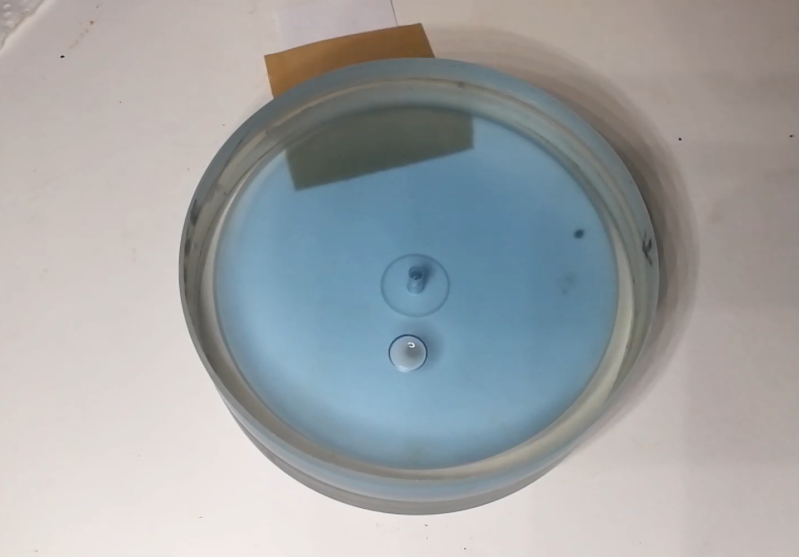Miss your shot and scratch on the eight ball? It’s natural to blame the table for not being level so you can save face, but in all likelihood, you’re probably right. [Huygens Optics]’s father never misses a billiards shot on his home table, until one day he did. [Huygens Optics] rushed to his aid and built an extremely precise spirit level for the table so it will never happen again.
First and foremost, he had to decide how sensitive the spirit level should be. Obviously, the table should be as level as possible, though other factors like the condition of the felt will come into play as well. In doing some calculations, he found that every degree of leveling error in the table translates to several millimeters of ball unevenness and deviation, so he wanted the level to have .01 degrees of accuracy. How he manages this feat of grinding and polishing in a hobbyist workshop is all captured in the fascinating video after the break.
The level is made from two disks cut from leftover 15mm borosilicate glass. Between the disks is a 4mm cavity for the liquid (ethyl alcohol) and the air bubble to move around. To avoid introducing error with uneven adhesive application, [Huygens Optics] tried to join the disks using optical contact bonding, wherein two surfaces stick together through the magic of intermolecular forces, like the one that keeps geckos attached to vertical things. That worked quite well until he added the liquid, which broke the bond. Instead, he used a thin, UV-curable epoxy.
Getting into optics doesn’t have to cost a lot. Instead of buying or grinding lenses for experimentation, you can laser-cut lens profiles out of acrylic.
Thanks to [Franz] and [David] for the tip.















Super similar to how one grinds and finishes a telescope lens or mirror! Never would have thought to use it for this purpose but it’s perfect. Sorry if this was mentioned in the video, I don’t have sound at the moment. Just wanted to say that’s really interesting to see a classic technique used in a new (to me at least) way.
Nice video and pertinent design, thanks for post :-)
FWIW: Wouldn’t be that difficultu to build level indication into a cue, few factors to consider not least of which is robustness. Would also be worthwhile to exploit the cue roll technique used to determine cue straightness to maximise precision. Not the sort of thing though you’d let some people use to play with but, hey can probably be done with some thought without increasing the backend cue mass by much and still retain balance even with some mid point adjustment, ah just sketched it ;-)
Cheers
This is giving me an idea… for actually making adaptive optics using a bubble trapped inside a vessel like this, where you would modify the focal by modifying the pressure inside the vessel…
Actually the name containing Optics made me think it was the presented concept :/
They make eye glasses with that sort of concept. Here’s a random article:
https://www.wired.com/2010/07/fluid-filled-adjustable-eye-glasses/
There used to be idea of “fluid lens” in mobile cameras. Interface of oil and water in vessel shaped by electric field.
I like this and am going to try making some optics this way. I do feel impelled to point out that you can buy a master precision level from MSC for $200, and it’ll give you (if my calculations are right) about 9E-7 degrees of accuracy.
A Starrett Master Precision level (Approx $1K) reads to 10 arc seconds (or 5 tenths per foot) which is 0.0025 degrees. 2.5e-3. You’re off by a good bit. I think the time and materials and special equipment you need to make one of those huge bubble levels works out to a lot more than the cost of a name-brand Master Precision level. My imported knockoff version isn’t quite as good but probably cost me maybe $79.
Experience true level: https://www.youtube.com/watch?v=-MwCJpEuC44
LoL
Back at yah, though been around here a few times by now, short & pertinent to my female friends ;-)
https://youtu.be/Dx6HojLBsnw
I actually got to use probably the most precise level there is a couple days ago.
It uses cups of water, with 3 point magnetic bases on each,connected by tubes, mirrors at the bottom of each one, a 3 point base depth micrometer with a modified anvil carrying a glass needle cut at 45 degrees to its axis, surrounded by a ring of letters for reference. The water self levels to the earth itself across all cups simultaneously, and the water is treated with an anti wetting agent to make the needle work better.
The depth mic is lowered until the needle just breaks water surface tension, and you note with which letter radially on the face of the anvil it cuts the mirror crosshair in the water.
This system is capable of leveling to sub 0.0001″ over 200 ft. Quite incredible. Look up EDS Precision Systems water levels.
Really cool here to see what it takes to make an optical level on your own though, I admire his dedication